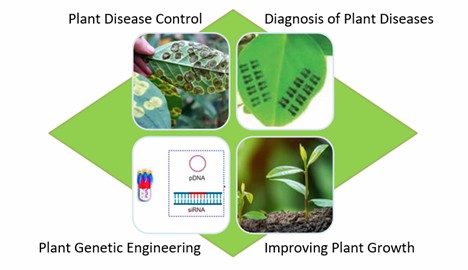Nanomaterials are used in plant protection, including plant disease control, plant disease detection, plant gene editing, and enhancing plant growth. Here, Lifeasible offers services to help explore the plant protection effects of nanomaterials for controlling plant disease and enhancing plant growth.

Nanomaterials developed using nanotechnology have become a unique class of modern materials. These materials have unique optical, electrical, thermal, and magnetic properties and have tunable physical and chemical properties. Nanomaterials with different properties have different plant protection applications. We offer services to help explore the plant protective effects and associated mechanisms of nanomaterials.
Anti-microbial effects of nanomaterials
We mainly provide services to study the direct anti-microbial effects of nanomaterials. Nanomaterials have various anti-microbial effects, including disrupting the structure of microorganisms, affecting their metabolism, and influencing their living environment. We offer to study the antimicrobial effects of nanomaterials starting from these three major directions. In disrupting microbial structure, we help study the disruptive effects and disruption mechanisms of nanomaterials on microbial cell membranes and cell walls. In affecting microbial metabolism, we help study nanomaterials' effects on microbial DNA replication, protein expression, and enzyme activity. In affecting microbial survival environment, we help study nanomaterials' effects on pH, temperature, O2, and other essential elements.
Anti-pest effects of nanomaterials
We offer services to help study the direct anti-pest effects of nanomaterials. We use research methods like those used to study the anti-insect effects of metabolites. Nanomaterials also have indirect anti-pest effects. Nanomaterials can stimulate plant immune mechanisms and thus improve the pest resistance of plants. Nanomaterials can also be used as pesticide carriers to improve the pest resistance of pesticides. We offer services to help study the role of nanomaterials in stimulating plant immunity and the mechanisms by which nanomaterials enhance pesticide efficacy.
Anti-viral effects of nanomaterials
Nanomaterials have basic anti-viral structures. Some nanomaterials can generate reactive oxygen species (ROS). Some nanomaterials have photo-dynamic and photo-thermal capabilities. We help study ROS properties' effect on the disruption of structures such as the viral envelope or capsid and on viral replication and assembly.
Herbicidal effects of nanomaterials
Both the application of herbicides in nano form and nanomaterials as carriers for herbicides contribute to improved weed control. In addition, some nanomaterials have direct damage to weeds. We mainly provide services to help study the direct damage effect of nanomaterials. We use research methods like those used to study the herbicidal mechanisms of metabolites.
Effects of enhancing plant photosynthesis
We offer services to help study how nanomaterials enhance photosynthesis in plants. We focus on four main aspects: enhancing the electron flow of photosynthesis, increasing the efficiency of light utilization, increasing the number of chloroplasts or photosynthetic pigments, and reducing the ROS damage of chloroplasts.
Effects of enhancing plant resistance to heavy metals
We help analyze the effects of nanomaterials on plant resistance to heavy metals from two aspects. The first aspect is the effects of the direct action of nanomaterials on heavy metals, including the uptake and transformation of heavy metals and the clean-up of ROS induced by heavy metals. The other aspect is that nanomaterials promote plant resistance to heavy metals, including stimulating the antioxidant capacity of plants, stimulating the secretion of plant protective substances (e.g., root exudates and organic acids), and enhancing the transport capacity of plants to heavy metals.
Effects of enhancing plant resistance to other abiotic stress
We offer services to study the role of nanomaterials in helping plants withstand other abiotic stresses (e.g., drought, salinity, low temperature, and flooding). We help study the general role of nanoparticles in helping plants resistance to abiotic stresses, including the removal of ROS, the promotion of plant photosynthesis, and the influence of plant metabolism. We will also conduct molecular and subcellular levels experiments to deeply analyze the resistance to specific abiotic stresses.
Lifeasible helps research the application of nanomaterials in plant protection and provides services to analyze the multiple roles of nanomaterials in plant protection. We will make a specific analysis according to the specific situation, please contact our technical support staff to customize your service.
Reference